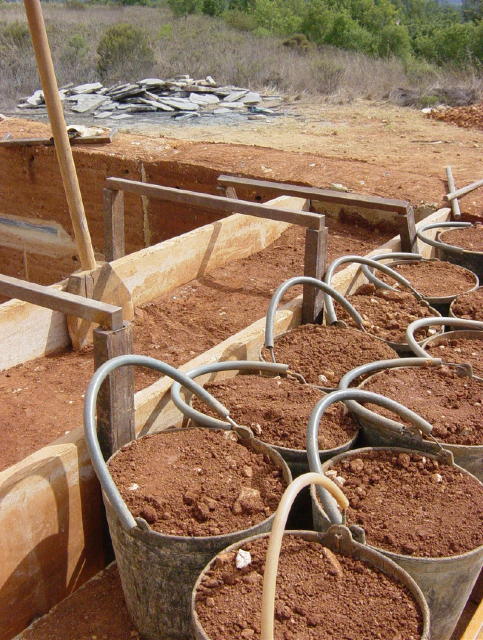![]()
ROGERS
RAMMED
EARTH
![]()
Frequently Asked Questions

Question: "What are the major advantages of Rammed Earthwalls?"
Answer: Earthwalls are a
natural material requiring only small amounts of
energy and endowing an enviromental
responsibility.
Earthwalls give a natural appearance and long
lasting quality, as well avoiding the "Sick
Building Syndrome" (Google it) of commercial
building products. Earthwalls have a very good
thermal capacity to heat or cool the house by
delayed heat transfer
e.g. walls cool off overnight and transfer
coolness during the summer day.
Earthwalls are cheap and very favourable for
owner-builders or isolated families,
who cannot cost wise easily obtain deliveries of
mainstream building material.
Unlike concrete, earth walls have a good
acoustic resonance.
Question: What does it cost?
Answer: Rammed
Earth for owner builders is very low-cost (dare
I say "dirt cheap") even if your earth is
delivered.
The low 5% addition of cement needed is unlikely
to blow out the budget, certainly cheaper than
delivered brick or cement block.
Even with hiring a carpenter to construct your
forms, these should easily be attained for a few
hundred dollars.
Commercial construction is a
different matter with pro-builders labour costs
bringing the budget
to a par with most other methods of mainstream
masonry construction.
Question: "How durable is Rammed Earth?"
Answer: Accelerated
erosion tests have been undertaken by the CSIRO
and the Natural Building and Technology Centre.
This involves ramming a test block of your
chosen earth, which is exposed to a high
pressure water jet for a set time.
Most samples will pass this test when stabilised
with as little as 5% cement.
Some local Councils may require this test to
pass your development application.
Eighty percent of the Great Wall of China was
rammed earth.
Built centuries ago & still standing albeit
erosion at top.

Potala. Lhasa, Tibet built
of Rammed Earth.
Question: "Can you use any soil?"
Answer: No. Topsoil is NOT suitable but most sub-soil/earths are suitable (no organic material).
Clayey earths need the
mixing in of sand & gravel. Sandy earth
needs clay.
Sand/gravel improves the range of particle sizes
which provides for easier mixing and compaction.
Clay provides the binding element for the earth
wall

Question: "Can on-site earth be used for the walls?"
Answer: Yes. Especially on larger land
portions with a greater area of selection.
Where only one earth type is available and it
is too narrow in composition, additives such
as sand, clay and fine gravel can be added.
A basic **DROP TEST** may be used for earth suitability:
Take a hand full of the
earth (**which should be damp only**) compact it
by squeezing hand tightly.
Then hold out the sample at chest height and
drop it on firm ground (eg:paving or
concrete)
The ideal sample should break up some what but
overall stay whole.
If the sample either breaks
up totally (too much sand) or stays in one lump
(too much clay) it is unsuitable.
This can be corrected by additions described in
the previous question/answer.
Question: "Can white ants be a problem?"
Answer: The CSIRO has published a technical report stating that termites will not burrow in rammed earth walls.

Question: "Does it matter that there is no wall cavity?"
Answer:
Rammed earth walls are
monolithic and have no cavity.
The walls are waterproof due to their clay
content and high compaction and repel water
in a similar way to the clay lining of a
dam.
Cavity walls can harbour insects,vermin
& rodents whereas
this is never a problem with rammed earth walls.
Question: "Why rammed earth walls and not mud brick?"
Answer: Mud
bricks require multiple handling to make
them and then to lay in place with mortar.
Compared to rammed earth walls which are
built in situ .
Mud bricks are weaker,not
structurally load bearing & need inbuilt
timber or steel columns to support the roof.
Mud brick is much less durable and labour
intensive, costs more.
Mud Bricks also have the tendency to be termite
farms.
Question: "What tools do I need to compact the earth?"
Answer: Commercial builders use an
air compressor driven tamper (see "Tech Page"
below).
A machine tamper is a considerable $ outlay to
purchase, especially the high capacity air
compressor.
Also it is very jumpy to use and abrasive on
light weight forms.
Owner builders who have time to build at their
own pace would be advised to use a hand held
tamper,
which is noise & vibration free, also less
like being a slave to a machine.
**Hand tamper actually gives a much better
quality COMPACTION which
is the KEY to
Rammed Earth**
This was the method used for centuries (Great
Wall China) and our early rammed earth building
pioneers, had no high tech tools.

Question: "Can walls be painted?"
Answer: Yes. But rammed walls really
only need two coats of clear low cost P.V.A.
(Bondcrete™) to seal walls.
Overall if desired walls can be tiled,
rendered, plastered, painted etc.
Additionally, lime washes and earth renders
can be applied to rammed earth walls.
But all these finishes add a
more intensive maintenance program to your home.
The precept of rammed earth is to be relatively
maintenance free.
If you choose light coloured earth then light reflection in the interior will be best.
Quesiton: "How well do rammed earth walls withstand fire?"
Answer: Depending on their thickness,
rammed earth walls have an approximate four
hour fire rating
which is the highest needed in Australian
building codes.
This is also good news for your insurance
premium.
Rammed Earth does not burn or emit toxic
chemicals as do most other building products.
further...Direct owner-builder questions.doc
Outdoor garden wall with

hand split hardwood shingle cap
(courtesy of Coochie Mudlo Island Mob.)
Roger will be happy to answer further inquiries if you use the Email below!
But only hearts can build a home
© 2025 All rights reserved.
Please ask first.
